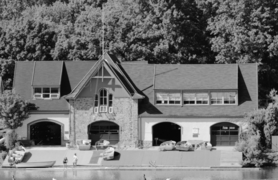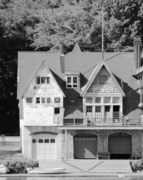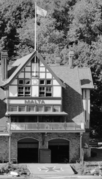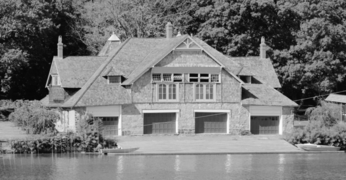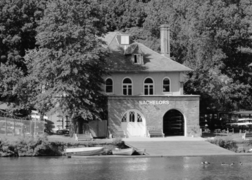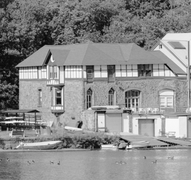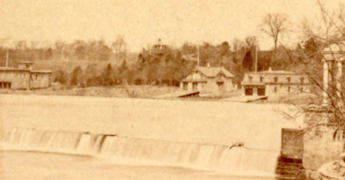Boathouse Row
Boathouse Row | |
Late Victorian; Gothic | |
| NRHP reference No. | 87000821[1] |
|---|---|
| Significant dates | |
| Added to NRHP | February 27, 1987 |
| Designated NHL | February 27, 1987 |
Boathouse Row is a
Boathouses #2 through #14 are part of a group known as the
History and importance
Boathouse Row hosts several major
The boathouses are seen as centers of the rowing community around the United States. Rowers from the boathouses compete at every level, including local clubs, high schools, colleges, summer racing programs, and international-level athletics.
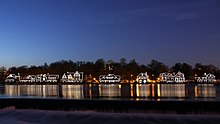
In 1979, lights designed by architectural lighting designer Ray Grenald were installed to outline each of the boathouses, giving them a nightly Christmas-like gingerbread house appearance and reflecting in the Schuylkill River.[3] He proposed the lights after hearing talk of destroying the decaying Victorian boathouses. Lights on the buildings at night would serve to make them more noticed and appreciated. In 2005, after two refurbishings, the houses were outfitted with computerized LEDs that can light up in various colors, depending on the event or season.
Boathouse Row is a National Historic Landmark and was listed on the National Register of Historic Places in 1987.[4]
Local universities including
Early 19th-century beginnings
The history of Boathouse Row begins with the construction of the Fairmount Dam and the adjacent
In 1835, the first regatta took place between the Blue Devils and the Imps Barge clubs.[7] The excitement from the race sparked the formation of several barge clubs, many of them short-lived.[7]
The frame boathouses
A secondary effect of taming the Schuylkill was that the calm water provided a breeding ground for mosquitoes, which drove wealthy residents from their riverside mansions.
In 1855, the city founded
Boathouses of 1860
Although the city condemned the frame boathouses, it passed an ordinance in 1860 to permit construction of three new boathouses for
Post–Civil War boathouses

Between 1869 and 1871,
Five years later, in 1883,
Photo gallery
Historic Landmark Boathouses in 1972
-
14 Kelly Drive(1860)
-
13 Kelly Drive(1883)
-
12 Kelly Drive(1878)
-
11 Kelly Drive(1874)
-
10 Kelly Drive(1873)
-
9 Kelly Drive(1873)
-
7-8 Kelly Drive(1871)
-
6 Kelly Drive(1894)
-
5 Kelly Drive(1871)
-
4 Kelly Drive(1892)
-
2-3 Kelly Drive(1904)
Miscellaneous images
-
Artist's rendition of the Row (c. 1860-71)
-
The Row with Lemon Hill in background (c. 1860-71)
-
Boathouse Row (c. 1873-74), from left to right: #7-8after one-story structures were removed
-
Boathouse Row from the Water Works (c. 1873-74)
-
Boathouse Row from Lemon Hill (c. 1873-74)
-
Boathouse Row (c. 1874-77), from left to right: ##12
-
Declassifiedspy satelliteimage of the Row
See also
- List of National Historic Landmarks in Philadelphia
- National Register of Historic Places in North Philadelphia
References
- ^ "National Register Information System". National Register of Historic Places. National Park Service. January 23, 2007.
- ^ "Lloyd Hall". Archived from the original on July 27, 2011. Retrieved May 11, 2010.
- ^ Saffron, Inga (January 7, 2005). "Lights Out". The Philadelphia Inquirer. pp. 1, 13.
- ^ National Register of Historic Places Inventory--Nomination Form Archived 2011-08-18 at the Wayback Machine
- ^ ISBN 978-0-8122-1693-6.
- ^ Archer B. Hulbert, The Paths of Inland Commerce, A Chronicle of Trail, Road, and Waterway, Vol. 21 The Chronicles of America Series. Editor: Allen Johnson (1921)
- ^ a b c d e f g h i j k l m Moak, Jefferson (November 27, 1983). "National Register of Historic Places Inventory--Nomination Form". NPS Focus, National Register of Historic Places, National Park Service, US Department of the Interior. p. 669. Retrieved May 7, 2010.
- ^ a b c "National Register of Historic Places Inventory--Nomination Form". NPS Focus, National Register of Historic Places, National Park Service, US Department of the Interior. November 27, 1983. p. 661. Archived from the original on February 27, 2014. Retrieved May 7, 2010.
- ^ Stillner, Anna (2005). The Philadelphia Girls' Rowing Club: An Incremental Historic Structure Report (Thesis). p. 28. Retrieved April 30, 2010.
- ^ "National Register of Historic Places Inventory--Nomination Form". NPS Focus, National Register of Historic Places, National Park Service, US Department of the Interior. November 27, 1983. p. 663. Archived from the original on February 27, 2014. Retrieved May 7, 2010.
- ^ "Seth S. Tannenbaum, Clifton R. Hood, & Mary D. McConaghy, College Boat Club, Penn Crew, archives.upenn.edu (April 2006)". Archived from the original on June 13, 2010. Retrieved May 26, 2010.
- ^ "National Register of Historic Places Inventory--Nomination Form". NPS Focus, National Register of Historic Places, National Park Service, US Department of the Interior. November 27, 1983. pp. 664–65. Archived from the original on December 14, 2012. Retrieved May 7, 2010.
- ^ Stillner, Anna (2005). The Philadelphia Girls' Rowing Club: An Incremental Historic Structure Report (Thesis). p. 106. Retrieved April 30, 2010.
- ^ Silverberg, Lee (May 19, 2008). "A Very Brief History of the Fairmount Rowing Association". Fairmount Rowing Association. Archived from the original on October 4, 2013. Retrieved May 1, 2010.
External links
- The Schuylkill Navy's website, with links to each of the Boathouse Row websites
- Info on Boathouse Row and Schuylkill Navy
- Boathouse Row, viewed from the air
- Historic American Buildings Survey (HABS) No. PA-1650, "Boathouse Row, East River Drive, Philadelphia, Philadelphia County, PA", 15 photos, 2 color transparencies, 2 data pages, 5 photo caption pages
- Boathouse Row on wikimapia.org






